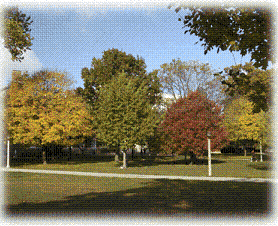A visit to Nebraska today wouldn't disclose that the state was once a treeless plain. Yet it was the lack of trees there that led to the founding of Arbor Day in the 1800's.
Among the pioneers moving into the Nebraska Territory in 1854 was J. Sterling Morton from Detroit, Michigan. He and his wife were lovers of nature and the home they established was quickly planted with trees shrubs and flowers.
Morton was a journalist and soon became the editor of Nebraska's first newspaper. Given that forum he spread agricultural information and his enthusiasm for trees to an equally enthusiastic readership. His fellow pioneers missed their trees, but more importantly, trees were needed as windbreakers to keep soil from blowing away and also for fuel and building materials, and they provided shade from the hot sun.
On January 4, 1872, at a meeting of the State Board of Agriculture. Morton first proposed a tree planting holiday to be called “Arbor Day. The date was set for April 10,1872. Prizes were offered to counties and individuals for planting the largest number of trees on that day. It was estimated that more than one million trees were planted in Nebraska that first Arbor Day.
In 1883 Arbor Day was named a legal holiday in Nebraska and April 22, Morton's birthday, was selected as the date for its permanent observance. The idea spread to other states through the years though it is observed on different dates according to the best time for planting trees. In New York it is on April 28. Morton's home in Nebraska City became known as Arbor Lodge and it contains extensive plantings of more than 160 species.
Morton died in 1902 and President Grover Cleveland dedicated a memorial to him at Arbor Lodge in 1905. One of Morton's own phrases adorns the marker, “Other holidays repose upon the past – Arbor Day proposes for the future.”
Imagine a world without trees, it would be very much different from the world we know today. Look around you, just about everything we have comes from trees; our homes, our furniture, food such as fruit, nuts, coffee, tea, spices and maple syrup. Think of all the beautiful musical instruments we have such as pianos, guitars, drums and violins. Many trees have medicinal properties and cures for diseases are being discovered all the time. Look at the paper this article was written on; look at our libraries and all the knowledge that we pass on from generation to generation. Even in the computer age paper is a part of the copying machine and people will always enjoy reading books, magazines and newspapers..
The very fact that people left their countries to start anew was attributed to the abundance of natural resources – especially trees which were the first fuel of the earliest civilizations.
This area was once thick forest and eventually Indians cleared the land for growing crops and later in the mid-1600's, the European settlers arrived and continued farming the land. Most woodland was cut to provide fuel for the development of Manhattan where the greatest population was located. Queens and Brooklyn were mostly rural until the building of the Brooklyn Bridge and Queesborough Bridge. There was a housing boom that started in the 1920's and has continued until today. Places where one house and a large yard were located now might have a large apartment house. In our area the trend seems to be that developers are buying up one and two family homes and converting them into six or more families with no yard and these developers make a good profit. As the population grows there will be a need for more schools, hospitals and businesses. All of this puts an enormous stress on the environment. The air quality in New York is not that good because of all the trucks, buses, cars and planes, so what can be done?
How to Help a Tree
Trees need all the help we can give them especially street trees. The average life of a street tree is seven years.They have to contend with vandalism, cars, diseases, dogs and lack of water. We can adopt a tree, give it water in hot weather, pull the weeds and discourage those that break branches and cut the bark. The city gives courses on being a citizen tree pruner so you can learn how to help trees. It costs the city $250 to plant a tree so it can get quite costly to keep planting another tree.
Organizations that can Help You
The Arbor Day Foundation was established to encourage the planting of trees in the city and country. They provide many educational programs and they make available to non-profit groups trees and plants for sale. To become a member or to receive information write to –
National Arbor Day Foundation
Arbor Lodge 100
Nebraska City, Nebraska 68410
New York City promotes the planting and maintenance of street trees and education the public on tree issues –
Trees New York
51 Chambers Street
New York, NY 10007
Contact your elected officials and ask them for more funding for trees in our parks, highways and streets.
10 Reasons for Planting Trees & Shrubs
1. Trees absorb air pollution and give off oxygen, thus cleaning the air we breathe. Trees also absorb noise pollution. In the hustle and bustle of city life noise has been found to be a cause of illness – people need quiet places to rest and think.
2. If your home is in the shade of a big tree you will save money on your air conditioning costs. It is about ten degrees cooler in the shade. On a hot day I couldn't sit out in my yard if it wasn't for my tree
3. Evergreen trees planted in our yard can block those cold winter winds and this will keep your home a little warmer, saving on our heating bills. If you have a fireplace you will save even more.
4. Trees can prevent heavy rainfall from washing the soil from your yard, because the leaves break the rainfall and the roots absorb the water and hold the soil.
5. Trees and shrubs give us privacy in a city where we have to live so close together, they can block out the sights and sounds of your neighbors and give you the feeling you are alone in the woods.
6. Trees improve property value. In fact many people spend thousands of dollars to landscape their property. Have you ever noticed the prices of some of the homes in neighborhoods like Forest Hills Gardens, Jamaica Estates, Malba, Bayside and Douglaston? Besides having large beautiful homes the streets and yards are lined with big beautiful trees and shrubs.
7. Trees provide food and shelter for birds, many animals and insects. Also many migrating birds depend on finding food and resting along their long journey and when trees are destroyed many other species also die off. In nature all things are connected.
8. Trees create topsoil when the leaves fall off and decay. The city also sells low cost compost bins to encourage us not to throw out our yard and kitchen waste. These bins can be bought at the Queens Botanical Gardens. The city also collects all the leaves and Christmas trees and makes compost and offers it free of charge. Instead of filling up trucks to dump waste in landfills we can give back to the earth and help keep it healthy by reducing our dependence on chemical fertilizers which pollute our waterways
9. They say it is good for the soil for us to get a little dirty in the garden by growing something from a seed. This is magical to see and a great learning experience for a child and also a comfort for the old-timers. With trees we see the changes of the seasons and withthe environment always changing we see the renewal of life.
10. In Forest Park a grove of pine trees was planted to commemorate the soldiers who died in World War I. When my daughter was born I planted a tree to mark the happy occasion. In Israel tree planting is done to memorialize the dead and to restore the land. At Christmas time we bring trees into our home and decorate them. From the beginning of time mankind has depended on, worshipped and exploited trees. Let's try to leave the world a little better place than we found it. Think of the future, plant a tree.



